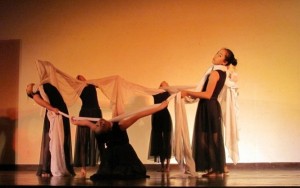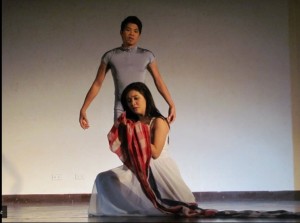By MA. CECILIA LOCSIN -NAVA
 TIME was when Ilonggos looked down on Antiqueños because in contrast to Iloilo and Negros, Antique is not as materially blessed. Not anymore.
TIME was when Ilonggos looked down on Antiqueños because in contrast to Iloilo and Negros, Antique is not as materially blessed. Not anymore.
Antique has blazed trails in the most unexpected arena.
Four decades before the Cultural Center of the Philippines initiated efforts to retool and update komedya, a play in verse usually about royal characters from imaginary European kingdoms, Exaltacion Combong, a teacher from Antique’s San Jose Elementary School, used it to, among others, to combat small town lottery and break down teachers’ resistance to the integration method of teaching.
Last May 25, Antique did it again.
The Hiraya Dance and Theater Company based in San Jose, the province’s capital, presented the dance drama “Lola Masing: A Tribute in Dance,” a first in Philippine dance theater, according to artistic director Alex Delos Santos.
It appears the only one who tackled the thorny topic of Filipino comfort women was Japanese artist Rei Arima in 2008 with her musical “Lola Masing” in Tokyo.
This is amazing when one considers the furor sparked by the confession of Maria Rosa “Lola Rosa” Henson, the first Filipina comfort woman to reveal in 1992 her ordeal in a military-run brothel for Japanese soldiers. Her account, Comfort Woman: Slave of Destiny (1996), raised public outcry over the Philippine government’s lukewarm response to the issue since Japan was a major aid donor.
While other comfort women accepted financial aid from the Asian Women’s Fund which the Japanese government put up in lieu of an apology, Lola Masing did not. This, despite the fact that the poor seamstress had to sell her blanket to finance her trip to Iloilo where she filed her case against the Japanese government.
Born Tomasa Dioso Salinog in Pandan, Antique, Lola Masing was 14 in 1942 when Japanese soldiers broke into their house and beheaded her father. She was raped and abused until Liberation came in June 1945.
Her steadfast insistence that the Japanese government officially apologize to all comfort women won her the admiration of Japanese sympathizers who raised funds to build her a house.
Unfortunately, she died on Good Friday, April 6, 2007, without seeing justice done for her and other comfort women. In 2002 the Japanese Supreme Court turned down all the comfort women’s claims of rape and sexual slavery.
But, with characteristic Antiqueño artistic penchant for mining the rich lode of local culture and history, Delos Santos turned her travails into a multi-layered dance drama, thanks to a grant from National Commission for Culture and the Arts.
 Pooling the best of Antique’s musical, dramatic and terpsichorean talents in a powerhouse cast headed by 2005 Lin-ay kang Antique g(Antique Ambassadress of Goodwill) Rubie Rizza Estaris who won as Best Female Artist in the recent Ilonggo Music Awards, the dance drama was musically scored by the award-winning tandem of composer-arranger Beny Castillon and Bimbo Muyuela whose avant garde “Kruhay” has been performed internationally.
Pooling the best of Antique’s musical, dramatic and terpsichorean talents in a powerhouse cast headed by 2005 Lin-ay kang Antique g(Antique Ambassadress of Goodwill) Rubie Rizza Estaris who won as Best Female Artist in the recent Ilonggo Music Awards, the dance drama was musically scored by the award-winning tandem of composer-arranger Beny Castillon and Bimbo Muyuela whose avant garde “Kruhay” has been performed internationally.
Datu Lubay Center resident dance instructor Crimson Guirgem of the Kawilihan-USA Dance Company choreographed the piece whose lead roles were powerfully handled by fellow resident dance instructor, Bernie Mailla and Jean Elizabeth Matias of Hiraya.
The dance drama opens with the sound of koto music juxtaposed with the first three bars of the Philippine national anthem. Significantly, the blanket/sash of bondage that Mailla wound around Estaris in their first dance sequence, evocative of the obi unraveling scene from Memoirs of a Geisha, introduced the theme that women are the greatest victims of war.
The reference to the sold blanket that was meant to right the wrong done Lola Masing turned sinister as it morphed into an instrument of torture underscored by a sequence where participants with scarves wound around their necks dance in a circle with one seemingly strangled dancer bending over backwards as a finale.
In tune too with the layered presentation was the effect of the woven blanket’s plaid pattern which under the lights took the semblance of the American flag’s stripes—an oblique reminder that it wasn’t just the Japanese who raped as part of the spoils of war but the Allied forces also.
Delos Santos made effective use of contrast in the idyllic celebratory barrio scene with its innocent games and tender courting scenes that clashed with the brutal rape scenes that immediately followed. This was underscored by the dancers’ vibrant red costumes that go counter to the somber blacks in the scenes that followed.
Unfortunately, this contrast was missing in the keening scene where all the women crawled on the floor in helpless grief. Did no one put up a resistance? Documents reveal many did and were either beaten up or killed, but this feistiness also helped them survive.
On the other hand, the testosterone-packed mixture of kuntaw, arnis and oriental dance in the frenzied fight scene to show the dehumanizing effects of war went big with an audience attuned to televised dance contests like “Got to Dance” and Paula Abdul’s “Live to Dance.” However, the projection of war scenes on the dancers’ bodies was neutralized by their sheer number.
While opening night’s kinks like the finale’s fiasco with the falling shroud can all be ironed out with fine-tuning, there was a crying need for a more rounded picture of Lola Masing’s life, especially after the war. Although many comfort women serviced as much as 50 men a day, their harrowing experience did not end with their release from sexual bondage.
Did Lola Masing find a husband as understanding as Lola Rosa’s Doming? Or did she suffer the fate of Gertrudes Basilisa of Legaspi City whose relatives mocked her and whose husband so despised her he treated her as though she had a contagious disease, stopped their children from calling her mother and eventually separated from her?
Whatever the answers, they would have considerably made the work more compelling aside from buttressing the dance drama’s thesis that in war it is women who suffer most.
More importantly, in raising suffering to the level of art, “Lola Masing: A Tribute in Dance” proved that despite the inequalities, artistically Antique can emerge on top of the heap in Western Visayas.
